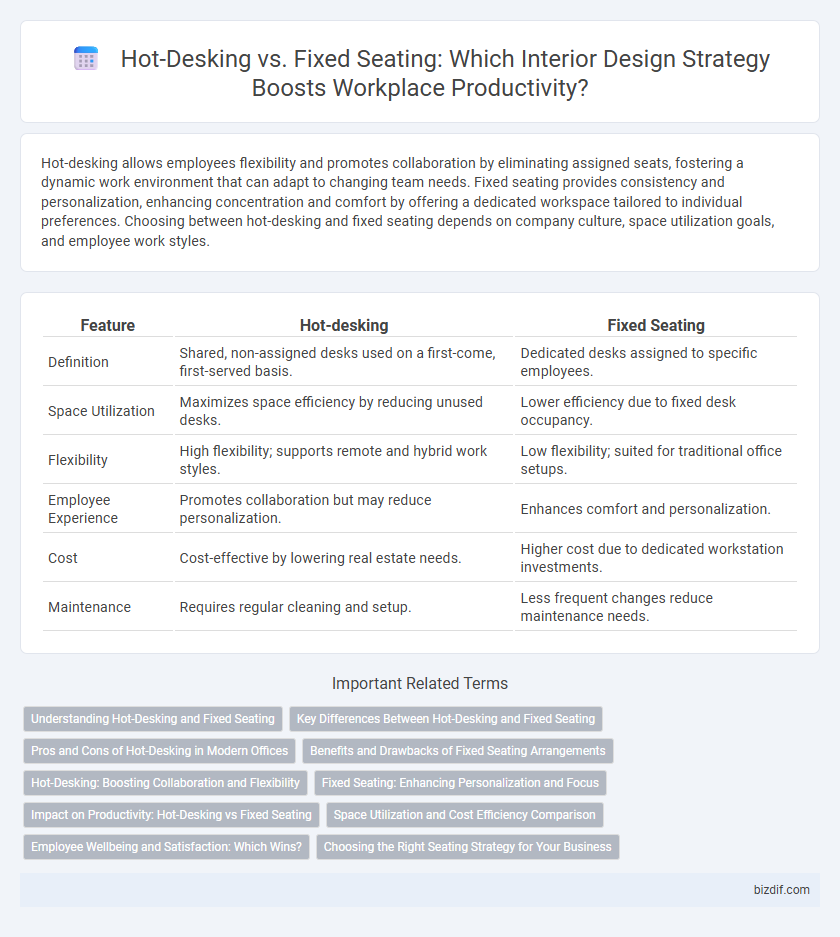Hot-desking allows employees flexibility and promotes collaboration by eliminating assigned seats, fostering a dynamic work environment that can adapt to changing team needs. Fixed seating provides consistency and personalization, enhancing concentration and comfort by offering a dedicated workspace tailored to individual preferences. Choosing between hot-desking and fixed seating depends on company culture, space utilization goals, and employee work styles.
Table of Comparison
| Feature | Hot-desking | Fixed Seating |
|---|---|---|
| Definition | Shared, non-assigned desks used on a first-come, first-served basis. | Dedicated desks assigned to specific employees. |
| Space Utilization | Maximizes space efficiency by reducing unused desks. | Lower efficiency due to fixed desk occupancy. |
| Flexibility | High flexibility; supports remote and hybrid work styles. | Low flexibility; suited for traditional office setups. |
| Employee Experience | Promotes collaboration but may reduce personalization. | Enhances comfort and personalization. |
| Cost | Cost-effective by lowering real estate needs. | Higher cost due to dedicated workstation investments. |
| Maintenance | Requires regular cleaning and setup. | Less frequent changes reduce maintenance needs. |
Understanding Hot-Desking and Fixed Seating
Hot-desking allows employees to use any available desk, promoting flexibility and efficient space utilization in dynamic office environments. Fixed seating assigns specific desks to individuals, enhancing personalization and consistent workspace organization. Understanding these concepts helps businesses optimize office layout based on collaboration needs and employee preferences.
Key Differences Between Hot-Desking and Fixed Seating
Hot-desking offers a flexible workspace where employees choose any available desk, promoting collaboration and efficient use of space, while fixed seating assigns specific desks to individuals for consistent personal space and asset customization. Hot-desking reduces real estate costs and supports dynamic work patterns, whereas fixed seating fosters a stable routine and personalized environment, enhancing comfort and productivity. Understanding these differences helps interior designers create office layouts that align with organizational culture and operational needs.
Pros and Cons of Hot-Desking in Modern Offices
Hot-desking offers flexibility by allowing employees to choose different workstations, which can optimize office space utilization and reduce real estate costs in modern offices. It fosters collaboration and dynamic interactions among team members but may lead to challenges such as lack of personal workspace, potential distractions, and decreased employee comfort. Effective hot-desking requires clear policies and hygiene practices to address concerns about shared spaces and ensure productivity.
Benefits and Drawbacks of Fixed Seating Arrangements
Fixed seating arrangements offer stability and predictability, fostering a consistent work environment that supports employee routines and personalization. These setups enhance team cohesion by facilitating straightforward communication and collaboration among designated groups. However, fixed seating can limit flexibility, potentially leading to inefficient space utilization and reduced adaptability in dynamic office environments.
Hot-Desking: Boosting Collaboration and Flexibility
Hot-desking enhances collaboration by encouraging employees to interact in diverse workspaces, fostering spontaneous communication and idea sharing. This flexible seating arrangement maximizes office space efficiency, reducing costs associated with unused desks. By promoting adaptability, hot-desking supports dynamic team structures and agile workflows in modern interior design.
Fixed Seating: Enhancing Personalization and Focus
Fixed seating in interior design maximizes personalization by allowing employees to customize their workspaces with personal items, ergonomic furniture, and specific lighting preferences. This seating arrangement enhances focus and productivity by providing a consistent and familiar environment, reducing distractions often caused by frequent changes. Businesses using fixed seating benefit from stronger team cohesion and tailored space planning that aligns with employee roles and needs.
Impact on Productivity: Hot-Desking vs Fixed Seating
Hot-desking enhances productivity by promoting flexibility and collaboration, allowing employees to choose workspaces tailored to specific tasks, which fosters creativity and efficient communication. Fixed seating provides stability and personalized environments that can reduce distractions and improve focus, benefiting employees who require routine and consistency. Organizations must balance the dynamic nature of hot-desking with the predictability of fixed seating to optimize overall workplace productivity.
Space Utilization and Cost Efficiency Comparison
Hot-desking maximizes space utilization by allowing multiple employees to share a single workstation, reducing the overall square footage required for office layouts. Fixed seating, while providing personalized and consistent work environments, often results in underused desks and higher real estate costs. Companies seeking cost efficiency benefit from hot-desking due to reduced office space rental and maintenance expenses, optimizing both budget and capacity.
Employee Wellbeing and Satisfaction: Which Wins?
Hot-desking fosters employee wellbeing by promoting flexibility, social interaction, and a dynamic work environment that can reduce stress and increase job satisfaction. Fixed seating offers stability, personal space, and consistent routines, which support comfort and a sense of belonging, enhancing overall employee morale. Studies show hybrid models combining both approaches often yield the highest satisfaction by balancing social connectivity with personal comfort.
Choosing the Right Seating Strategy for Your Business
Hot-desking boosts workplace flexibility by allowing employees to choose any available desk, optimizing space and reducing overhead costs, which suits dynamic teams and hybrid work models. Fixed seating provides stability and personal space, fostering employee comfort and collaboration, beneficial for roles requiring consistent setups or team proximity. Analyzing business needs, employee work styles, and office layout helps determine the ideal seating strategy to enhance productivity and employee satisfaction.
Hot-desking vs Fixed seating Infographic

 bizdif.com
bizdif.com